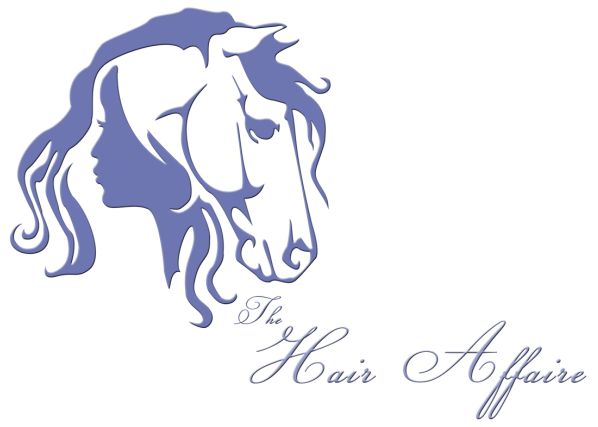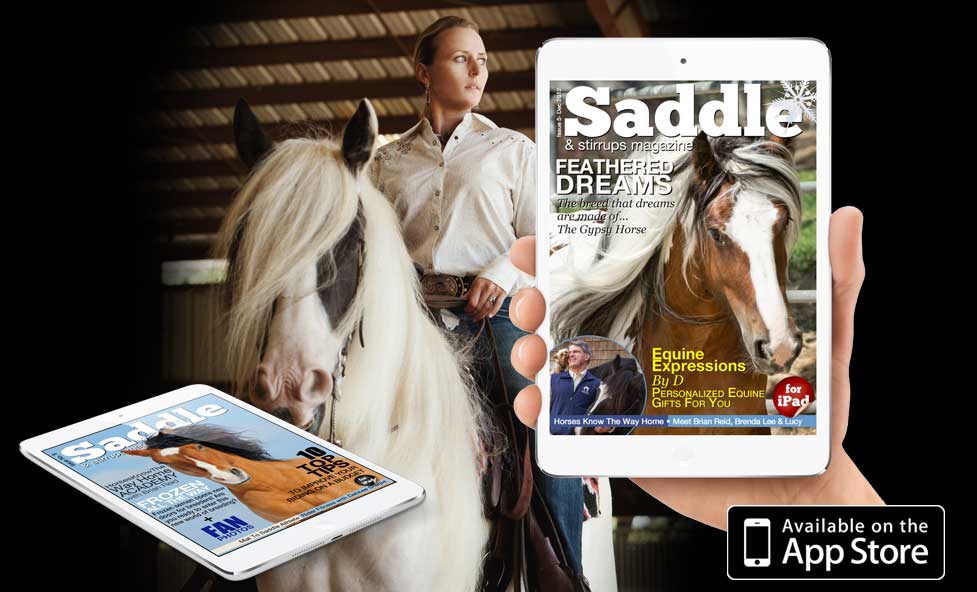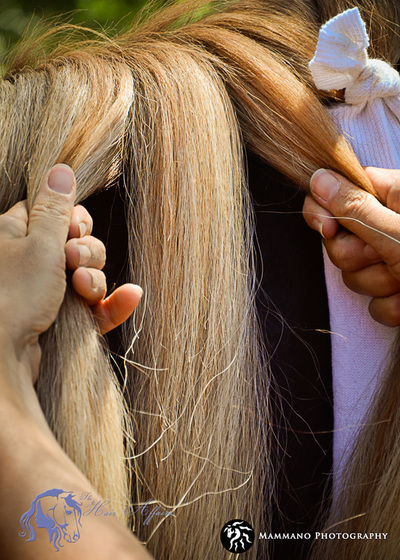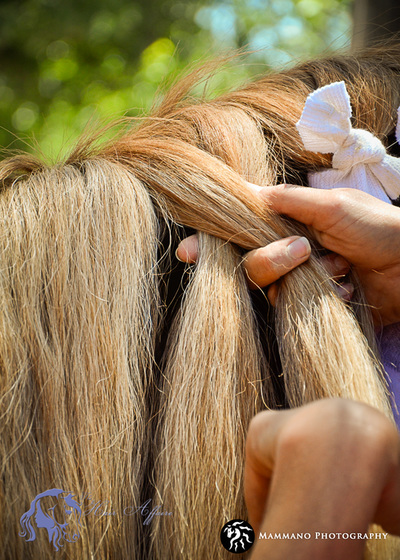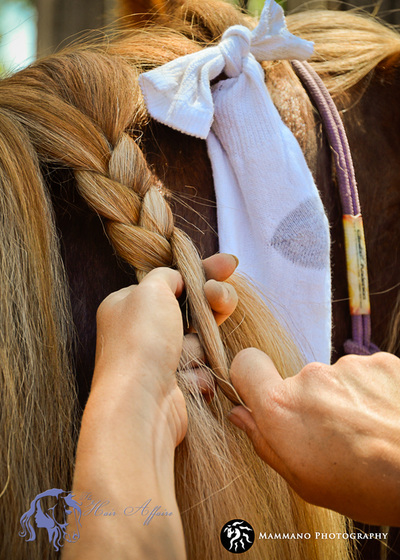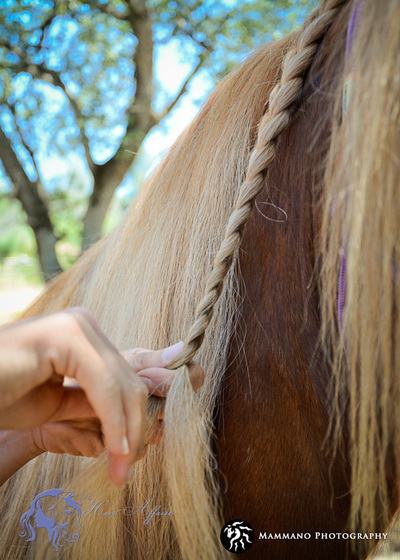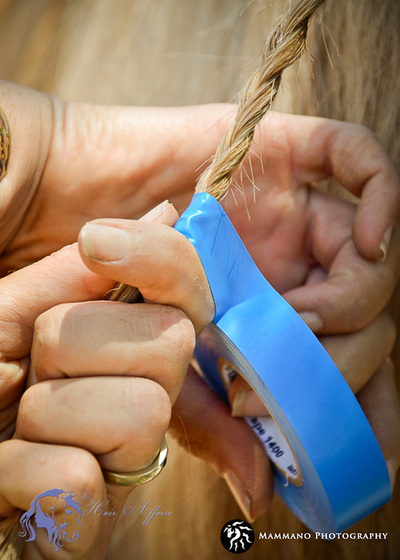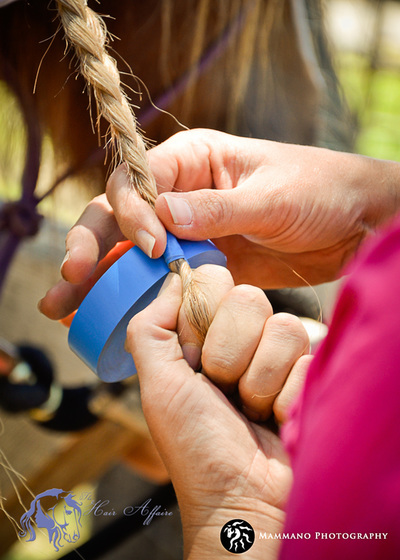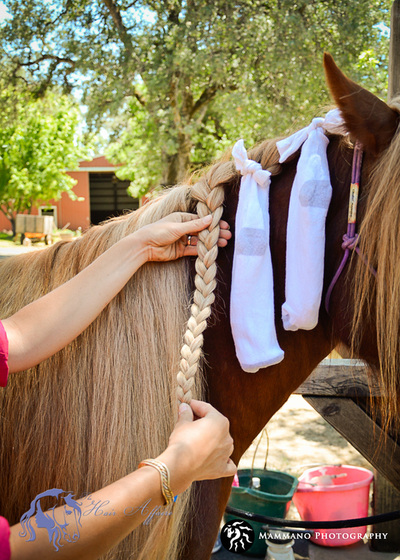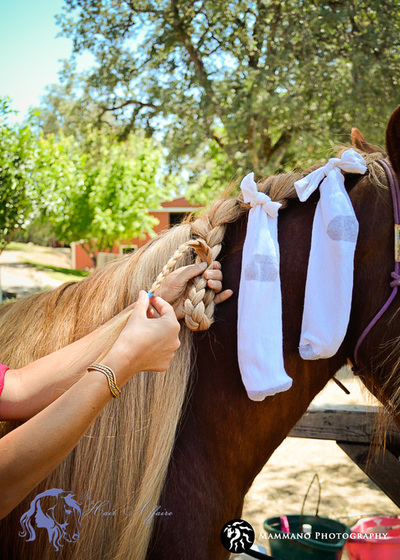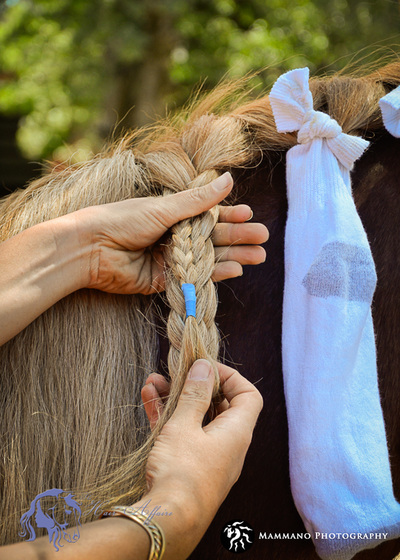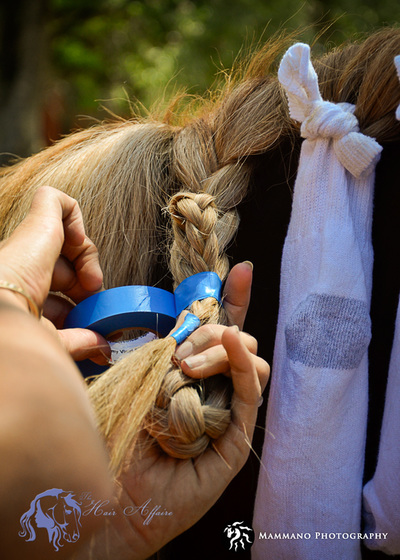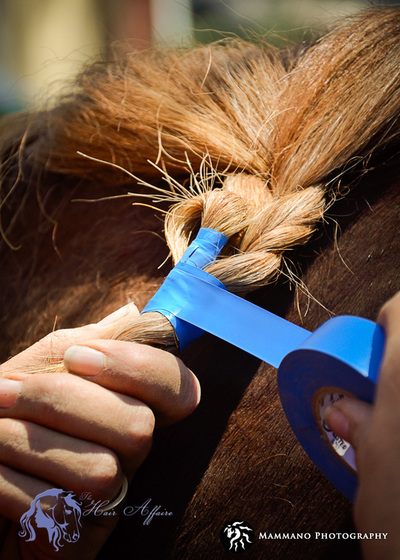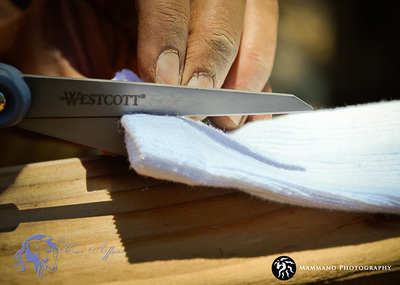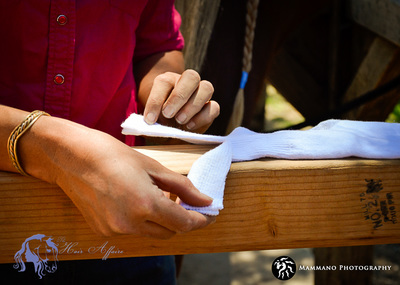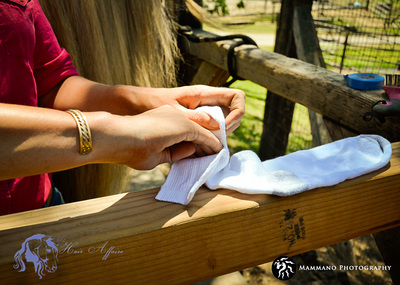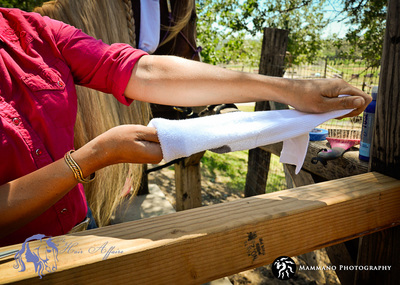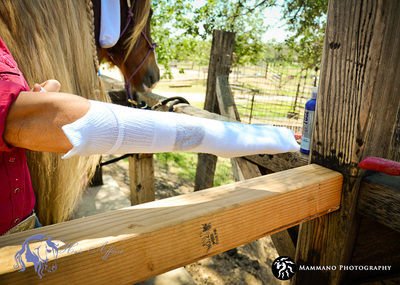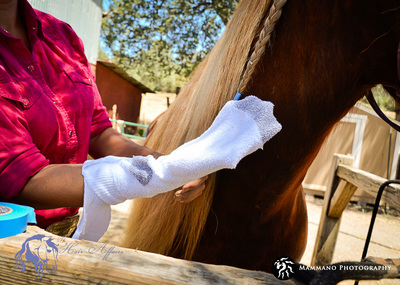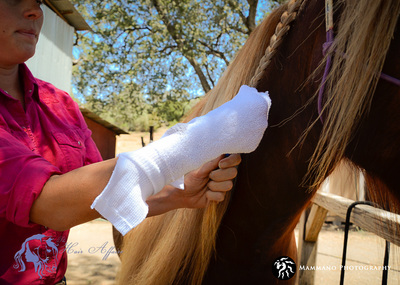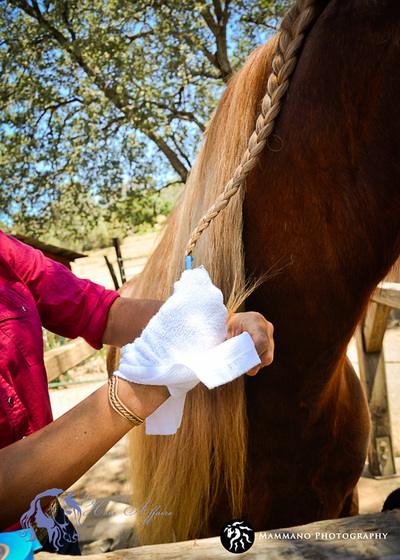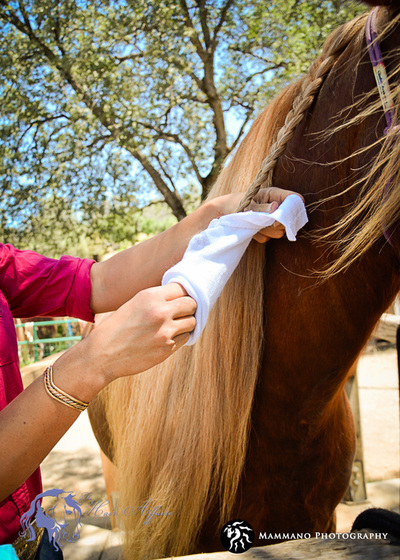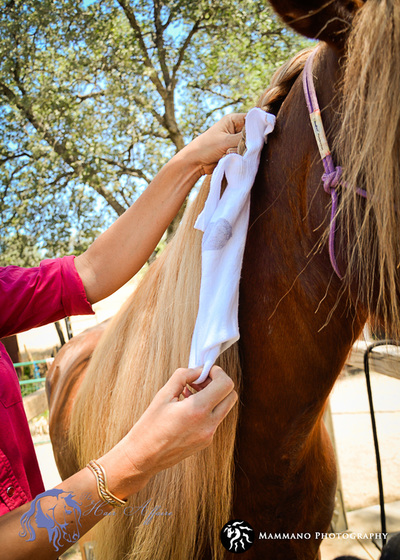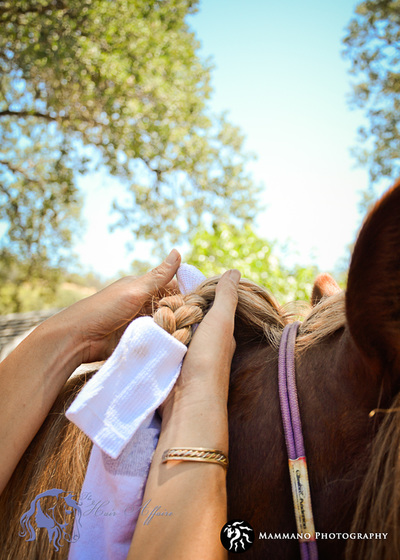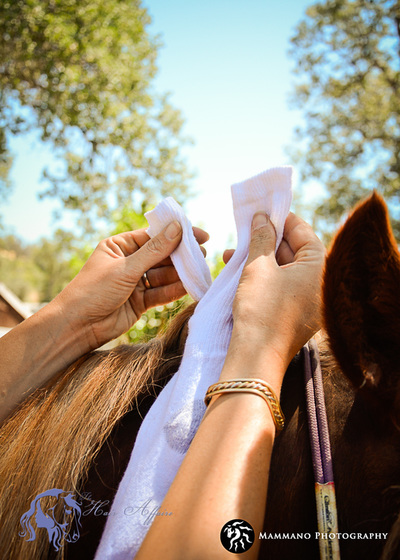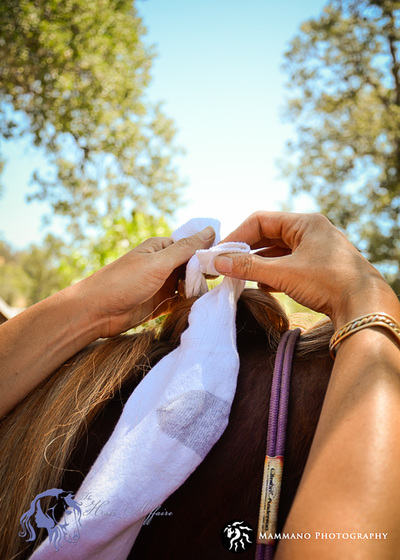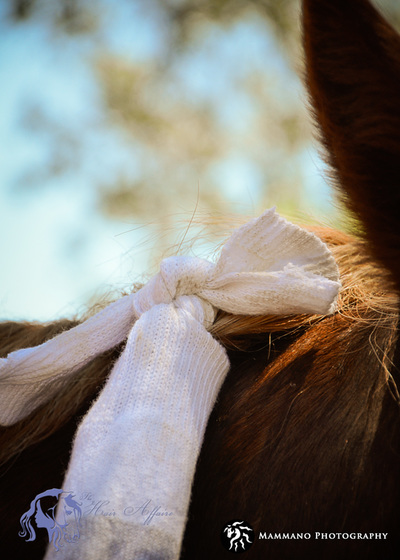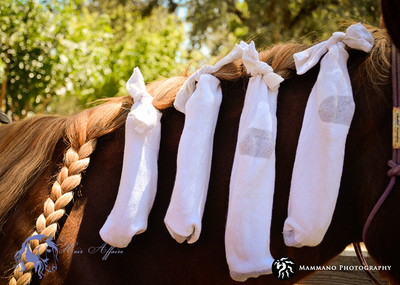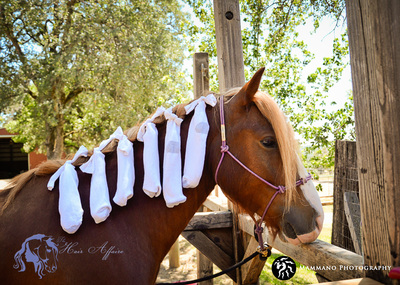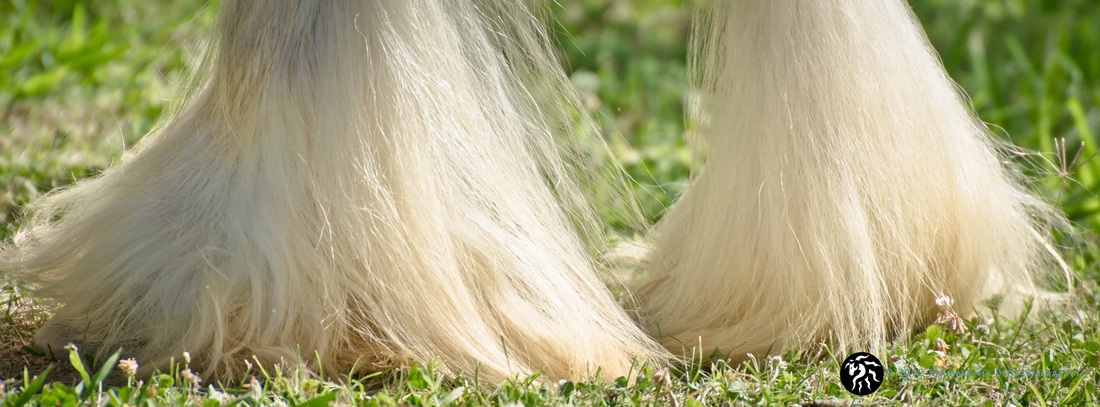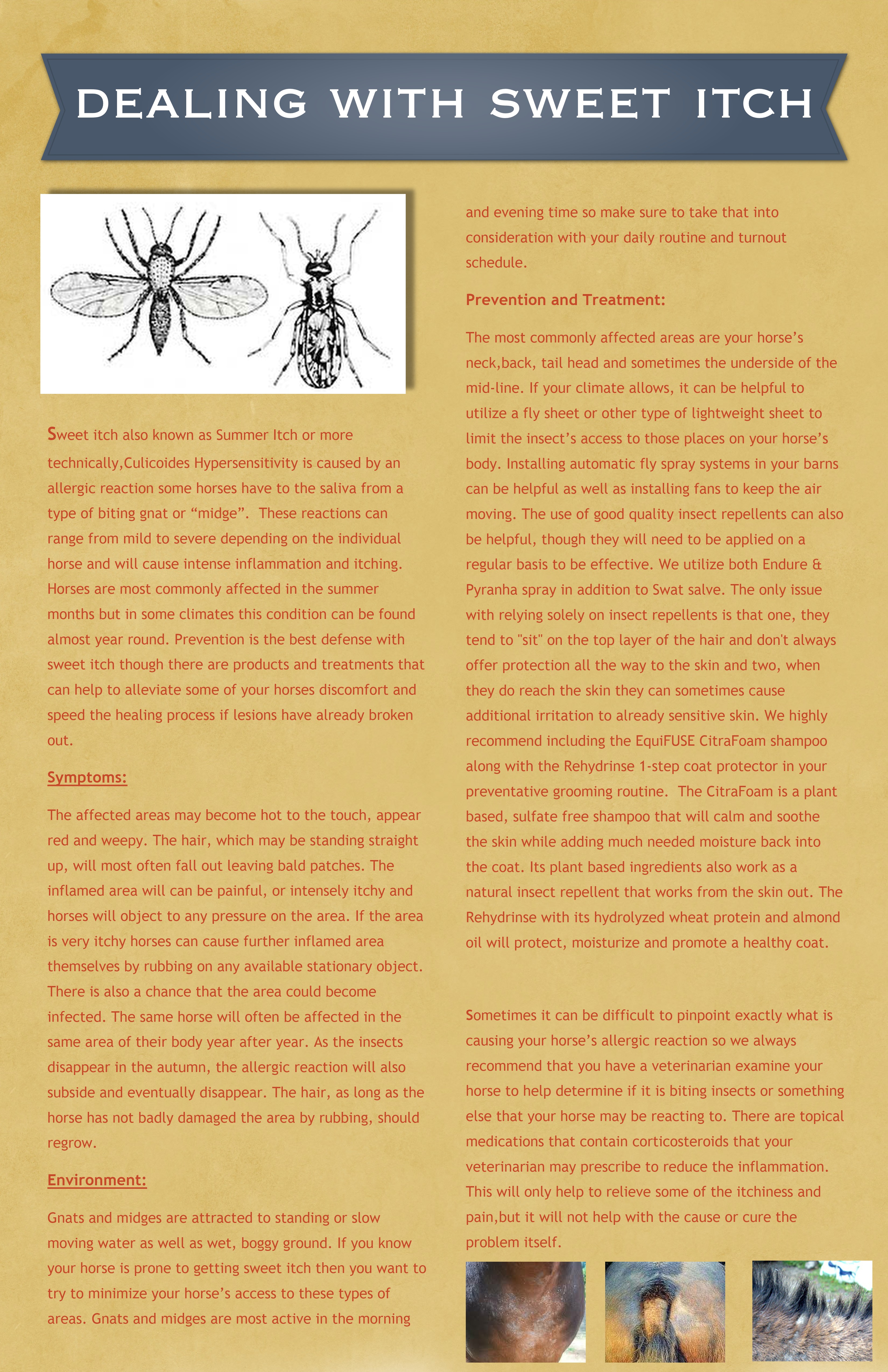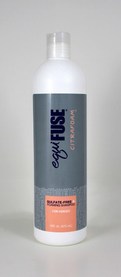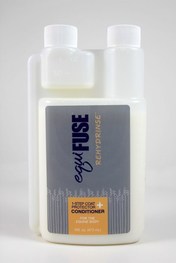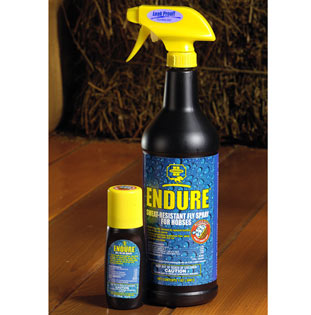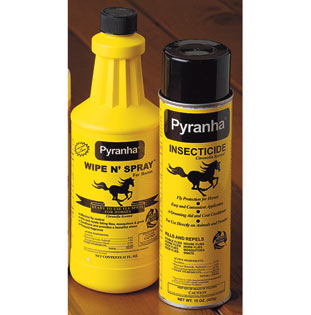Helpful Grooming Hints & Tips
No matter what breed of horse you own or what discipline you prefer, we all love seeing that well groomed, healthy glow on our horses. Grooming is a part of every horse owner’s life and whether you are preparing your horse for the show ring, getting ready to hit the trails or just spending some quality time bonding with your best friend. Below you can find some helpful hints, tips and tricks that can make your grooming sessions easier and more productive.
Basic Grooming:
· ~ Mud and dirt have a tendency to dry out your horse’s hair. Make sure to start each grooming session with a vigorous rub down using a rubber curry. This will bring mud and dirt to the surface of the coat for easy removal with a body brush. It will also help to stimulate your horse’s circulation and encourage production of the natural oils your horse produces for a beautiful, healthy shine.
· ~ When brushing your horse’s mane and tail always start at the ends and work your way up. Hold each section of hair in one hand, right above where you are working so that you can accurately gauge the amount of tension or strain that you are applying to the hair. If you hit a spot that is tangled or snarled stop brushing, apply detangler to that section of hair and then work through the knot using your fingers to gently separate the hairs until you can run the brush through the hair without breaking off or tearing out the strands.
· ~ Use grooming tools specifically designed for manes and tails. Human hairbrushes can break the hair as well as pull it out at the root. Look for mane and tail brushes with well spaced bristles as they are less likely to get snagged in your horse’s hair. We personally use and recommend the Oster Mane & tail brush.
· ~ In the wintertime it can be too cold for a proper bath but that never seems to deter horses from playing in the mud. If you need to remove mud or dirt from your horse's mane or tail all you need is a warm, damp washcloth and a good moisturizing serum (we use the EquiFUSE Gleam for this). Take one section of hair at a time, starting at the root, wrap the washcloth around the hair and work your way down. Make sure to rinse the cloth and ring it out well after cleaning each section of hair so excess water doesn't drip onto the horse’s body. After the hair is reasonable clean, work a small amount of the moisturizing serum through the hair to help keep more mud and dirt for sticking to the hair.
· ~ To help protect against skin infections make sure to regularly disinfect all grooming brushes and combs. If you have new horses that come in it can be helpful to have an extra set of grooming tools to use specifically on them for the first few weeks. This way you won’t accidentally pass a fungal or other type of infection to your other horses.
· ~ Always try to rinse the sweat off of your horse after exercise as sweat build up can lead to rubbing (and subsequent hair loss) and it can also accelerate your horse's coat fading in the sun. If it is too cold to rinse your horse then make sure to give them a good rubdown with a clean towel or cloth and then remove any sweat residue with a stiff brush when the coat is dry.
· ~ If your horse is kept in pasture or has access to turn out, make sure to include products with added sunscreen to your grooming routine. This will help to protect their coat from harmful UV rays and reduce fading.
· ~ Regularly check the underside of your horse’s tail, in between your mare’s teats and your stallion or gelding’s sheath for any signs of grime build-up or irritation. By keeping these areas clean you can reduce the chance of infection and eliminate one of the major causes of rubbing and hair loss.
Bath Time:
· ~ Invest in good shampoos and conditioners that are formulated for equine use. While products designed for humans will work in a pinch, they tend to leave your horses hair dry and brittle. Our personal favorite is the EquiFuse product line because their non-drying formulas add moisture and shine back into the hair without using harsh chemicals that damage the skin and coat as well as leave unnecessary buildup.
· ~ Soak knots and tangles in the mane or tail with detangler and then gently separate the knots before you begin bathing, otherwise the shampoo and conditioner will not be able to reach the hair that is trapped in the center of the knot and you will end up with dirty and unmoisturized areas in the hair when you are finished.
· ~ After applying your shampoo and conditioner, make sure your horse is thoroughly rinsed, paying special attention to the base of the tail and the crest of the mane. Product residue can not only clog the pores leading to slower hair growth but it can also cause rubbing and hair loss due to skin irritation.
· ~ If you use sponges as part of your grooming or bathing routine with your horse make sure to have separate sponges for the face, body and dock area. Having different shaped or colored sponges for different areas can make this much easier.
· ~ When washing a very thick mane it can be helpful to shampoo it in two stages. Start on the ‘outside’, where the hair naturally lies, working your shampoo or conditioner in as well as you can. Then flip the mane over to the other side of the neck and start the whole process again. When you go to rinse the mane remember to repeat this process or you can end up with product being left in the hair.
· ~ When washing you horse’s mane or tail you can stimulate hair growth by vigorously massaging the root bed with your fingertips. This also loosens up any dead skin or other irritants that inhibit the healthy production of hair from the follicles.
· ~ For conditioning especially thick manes and tails it can be helpful to mix your conditioner with water and apply with a spray bottle. This will allow you to evenly distribute the product throughout the hair and it will help cut down on product waste.
· ~ Protect your horse’s tail while it dries by tying it up in a simple slip knot. This will keep your horse’s tail up off the ground while it dries helping to keep it clean and it will still dry quickly. This is especially important if you horse has a long tail as the hair will stretch a bit while wet and the horse can end up stepping on it.
· ~ Hair stretches when it is wet which actually makes it more forgiving. While your horse’s mane or tail is drying you can gently pick through it by hand, separating the strands and removing small tangles. This way when the hair dries it will lie neatly and be easier to run a brush through.
Braiding:
· ~ Braiding of the mane and tail, if done correctly and maintained can be a great way to protect you horse’s hair from UV damage, reduce tangles and promote growth.
· ~ When you are braiding the mane, braids should be approximately one inch wide and should start a couple inches from the crest so as not to put unnecessary stress and tension on the roots. Tails can be braided into one large braid or multiple smaller braids depending on the thickness of the tail. Braids can then be put into tail bags or socks to further reduce damage from the dirt and sun.
· ~ Depending on your horse and the condition of the braids, they should be taken out once a week to once a month so the hair can be cleaned and conditioned. This will also ensure that the hair doesn't become matted and tangled from rolling or swishing at flies.
· ~ When you take out your horse's braids make sure to straighten and organize the hair using your fingers, rather than a brush or comb. The hair will be wavy from being in the braid and combing it will only make it frizzy. The best way to remove the waves is to wash and moisturize the hair before combing and re-braiding it. If it is too cold to bathe or you don't have the time then you can also spray a mixture of EquiFUSE Rehydrinse and water (1/4-1/2oz of Rehydrinse to 1 bottle of water) onto the hair until it is slightly damp and then re-braid.
· ~ Remember that wet hair will contract as it dries so plan accordingly if you braid your horse’s hair while it is still damp. Make sure that your braids are loose enough that they won't end up pulling the hair out at the roots as it dries.
· ~ Because the natural oils your horse produces will have a harder time traveling down the hair shaft while it is braided you want to make sure that the hair is properly conditioned before it is put into braids as it will only continue to dry out further.
· ~ When securing the ends of your braids you want to be careful using rubber bands as they can easily tangle in the hair causing breakage. We recommend either bands that are covered in fabric or my personal favorite is banding or electrical tape as they are easy to remove and leave no residue.
· ~ If your goal with braiding is to promote hair growth then we highly recommend the product M-T-G made by Shapley’s. The best method we have found is to apply it along the crest and the base of the tail and work it into the skin each time you re-braid. We have seen up to 4 inches of hair growth on some horses in only one month while using this product. The M-T-G will also help alleviate dry skin and fungal issues that can lead to rubbing and hair loss.
If you have any questions about the methods or products mentioned in this article or if you have a grooming issue that you would like to see covered ,please feel free to contact us by filling out the form below. We are always happy to answer any questions.
Basic Grooming:
· ~ Mud and dirt have a tendency to dry out your horse’s hair. Make sure to start each grooming session with a vigorous rub down using a rubber curry. This will bring mud and dirt to the surface of the coat for easy removal with a body brush. It will also help to stimulate your horse’s circulation and encourage production of the natural oils your horse produces for a beautiful, healthy shine.
· ~ When brushing your horse’s mane and tail always start at the ends and work your way up. Hold each section of hair in one hand, right above where you are working so that you can accurately gauge the amount of tension or strain that you are applying to the hair. If you hit a spot that is tangled or snarled stop brushing, apply detangler to that section of hair and then work through the knot using your fingers to gently separate the hairs until you can run the brush through the hair without breaking off or tearing out the strands.
· ~ Use grooming tools specifically designed for manes and tails. Human hairbrushes can break the hair as well as pull it out at the root. Look for mane and tail brushes with well spaced bristles as they are less likely to get snagged in your horse’s hair. We personally use and recommend the Oster Mane & tail brush.
· ~ In the wintertime it can be too cold for a proper bath but that never seems to deter horses from playing in the mud. If you need to remove mud or dirt from your horse's mane or tail all you need is a warm, damp washcloth and a good moisturizing serum (we use the EquiFUSE Gleam for this). Take one section of hair at a time, starting at the root, wrap the washcloth around the hair and work your way down. Make sure to rinse the cloth and ring it out well after cleaning each section of hair so excess water doesn't drip onto the horse’s body. After the hair is reasonable clean, work a small amount of the moisturizing serum through the hair to help keep more mud and dirt for sticking to the hair.
· ~ To help protect against skin infections make sure to regularly disinfect all grooming brushes and combs. If you have new horses that come in it can be helpful to have an extra set of grooming tools to use specifically on them for the first few weeks. This way you won’t accidentally pass a fungal or other type of infection to your other horses.
· ~ Always try to rinse the sweat off of your horse after exercise as sweat build up can lead to rubbing (and subsequent hair loss) and it can also accelerate your horse's coat fading in the sun. If it is too cold to rinse your horse then make sure to give them a good rubdown with a clean towel or cloth and then remove any sweat residue with a stiff brush when the coat is dry.
· ~ If your horse is kept in pasture or has access to turn out, make sure to include products with added sunscreen to your grooming routine. This will help to protect their coat from harmful UV rays and reduce fading.
· ~ Regularly check the underside of your horse’s tail, in between your mare’s teats and your stallion or gelding’s sheath for any signs of grime build-up or irritation. By keeping these areas clean you can reduce the chance of infection and eliminate one of the major causes of rubbing and hair loss.
Bath Time:
· ~ Invest in good shampoos and conditioners that are formulated for equine use. While products designed for humans will work in a pinch, they tend to leave your horses hair dry and brittle. Our personal favorite is the EquiFuse product line because their non-drying formulas add moisture and shine back into the hair without using harsh chemicals that damage the skin and coat as well as leave unnecessary buildup.
· ~ Soak knots and tangles in the mane or tail with detangler and then gently separate the knots before you begin bathing, otherwise the shampoo and conditioner will not be able to reach the hair that is trapped in the center of the knot and you will end up with dirty and unmoisturized areas in the hair when you are finished.
· ~ After applying your shampoo and conditioner, make sure your horse is thoroughly rinsed, paying special attention to the base of the tail and the crest of the mane. Product residue can not only clog the pores leading to slower hair growth but it can also cause rubbing and hair loss due to skin irritation.
· ~ If you use sponges as part of your grooming or bathing routine with your horse make sure to have separate sponges for the face, body and dock area. Having different shaped or colored sponges for different areas can make this much easier.
· ~ When washing a very thick mane it can be helpful to shampoo it in two stages. Start on the ‘outside’, where the hair naturally lies, working your shampoo or conditioner in as well as you can. Then flip the mane over to the other side of the neck and start the whole process again. When you go to rinse the mane remember to repeat this process or you can end up with product being left in the hair.
· ~ When washing you horse’s mane or tail you can stimulate hair growth by vigorously massaging the root bed with your fingertips. This also loosens up any dead skin or other irritants that inhibit the healthy production of hair from the follicles.
· ~ For conditioning especially thick manes and tails it can be helpful to mix your conditioner with water and apply with a spray bottle. This will allow you to evenly distribute the product throughout the hair and it will help cut down on product waste.
· ~ Protect your horse’s tail while it dries by tying it up in a simple slip knot. This will keep your horse’s tail up off the ground while it dries helping to keep it clean and it will still dry quickly. This is especially important if you horse has a long tail as the hair will stretch a bit while wet and the horse can end up stepping on it.
· ~ Hair stretches when it is wet which actually makes it more forgiving. While your horse’s mane or tail is drying you can gently pick through it by hand, separating the strands and removing small tangles. This way when the hair dries it will lie neatly and be easier to run a brush through.
Braiding:
· ~ Braiding of the mane and tail, if done correctly and maintained can be a great way to protect you horse’s hair from UV damage, reduce tangles and promote growth.
· ~ When you are braiding the mane, braids should be approximately one inch wide and should start a couple inches from the crest so as not to put unnecessary stress and tension on the roots. Tails can be braided into one large braid or multiple smaller braids depending on the thickness of the tail. Braids can then be put into tail bags or socks to further reduce damage from the dirt and sun.
· ~ Depending on your horse and the condition of the braids, they should be taken out once a week to once a month so the hair can be cleaned and conditioned. This will also ensure that the hair doesn't become matted and tangled from rolling or swishing at flies.
· ~ When you take out your horse's braids make sure to straighten and organize the hair using your fingers, rather than a brush or comb. The hair will be wavy from being in the braid and combing it will only make it frizzy. The best way to remove the waves is to wash and moisturize the hair before combing and re-braiding it. If it is too cold to bathe or you don't have the time then you can also spray a mixture of EquiFUSE Rehydrinse and water (1/4-1/2oz of Rehydrinse to 1 bottle of water) onto the hair until it is slightly damp and then re-braid.
· ~ Remember that wet hair will contract as it dries so plan accordingly if you braid your horse’s hair while it is still damp. Make sure that your braids are loose enough that they won't end up pulling the hair out at the roots as it dries.
· ~ Because the natural oils your horse produces will have a harder time traveling down the hair shaft while it is braided you want to make sure that the hair is properly conditioned before it is put into braids as it will only continue to dry out further.
· ~ When securing the ends of your braids you want to be careful using rubber bands as they can easily tangle in the hair causing breakage. We recommend either bands that are covered in fabric or my personal favorite is banding or electrical tape as they are easy to remove and leave no residue.
· ~ If your goal with braiding is to promote hair growth then we highly recommend the product M-T-G made by Shapley’s. The best method we have found is to apply it along the crest and the base of the tail and work it into the skin each time you re-braid. We have seen up to 4 inches of hair growth on some horses in only one month while using this product. The M-T-G will also help alleviate dry skin and fungal issues that can lead to rubbing and hair loss.
If you have any questions about the methods or products mentioned in this article or if you have a grooming issue that you would like to see covered ,please feel free to contact us by filling out the form below. We are always happy to answer any questions.
~ Protecting Those Braids ~
Treating scratches
1. Wash the affected legs with mild shampoo such as EquiFUSE CitraFoam or a baby shampoo and then rinse well.
2. Wash again with a solution of warm water and Betadine surgical scrub and rinse well. Make sure to dry the legs well with either a towel or a blow dryer on low.
3. Apply a thin layer of Tomorrow mastitis cream (you can also use Masti-Clear or another type of mastitis medication) to the affected areas once a day for 3 days.
4. On the fourth day prepare a mixture of equal parts Desitin cream, Neosporin ointment and Cortisone cream in a small container.
5. Apply this mixture to the effected areas on legs and pasterns once a day until the skin has healed.
Unless the legs become too dirty you can just wipe and reapply without having to wash the legs every time.
~The desitin acts as a moisture barrier, the antibiotic helps to treat the infection, and the cortisone is an anti-inflammatory~
The method listed above is very similar to the "Fran Scott Method" developed by Fran Scott. We would like to thank her for all the countless hours she has put into helping to educate the equestrian community about grooming and health issues!
